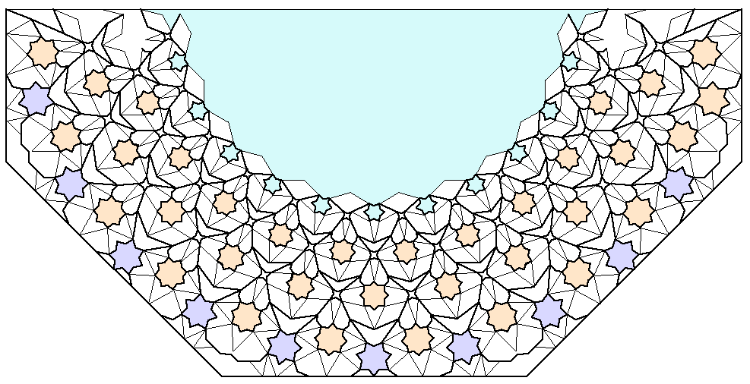muqarnas in Uzbekistan
Muqarnas constructions within a rectangular or triangle frame with a set of elements placed in layers. This way of constructing muqarnas you can find in Uzbekistan in Mizdakhan (14th century).
![Muqarna in [url=https://www.geogebra.org/m/u3d8sx2h#material/muzg4etf]Mizdakhan[/url] (14th century) based on a tiling with squares, rhombuses and triangles
drawing: Shiro Takahashi](https://www.geogebra.org/resource/dhh2ctfr/uvYh9GK5NsGgnk58/material-dhh2ctfr.png)
But this is just one type of muqarnas. In Uzbekistan one can clearly see an evolution. In the early 15th century muqarnas of Samarkand (e.g. the Gur Emir mausoleum) cells other than these of the traditional set are used. The focus now is to create star shaped elements. Other side faced are created just to connect these stars, placed on different levels..
![floor plan of muqarna in [url=https://www.geogebra.org/m/u3d8sx2h#material/ub37prgd]Samarkand- Gur Emir mausoleum[/url] (early 15th century)
drawing: Shiro Takahashi](https://www.geogebra.org/resource/nd57mycf/nVFOn5kcmD1xyEBJ/material-nd57mycf.png)
The system in which the focus is on concentric circles with stars is called the polai system of muqarnas, one also speaks of stalachtites.
This type of muqarnas is prominent in the 17th and 18th century monuments in Bukhara. In the drwawing of the floor plan of such muqarnas one can clearly see the circles. The points of the stars on the different layers are connected, forming de the side faces of the muqarna.
The drawing is from Shiro Takahashi, who created a large list on his website .
